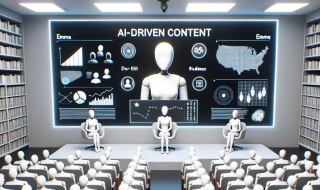The Collapse scenario
The 'Collapse' scenario
Decay, in the shadow of big tech
It is 2040 and Emma wakes up in her small, concrete room. She checks her old smartphone and is informed of her daily schedule by an emotionless AI tutor: online meetings and a lecture on campus. The tutor's role is marginalised; AI-driven programmes deliver impersonal teaching that lacks human interaction due to lack and manpower and resources. After a laborious online session, she cycles to the far-flung campus, with neglected facilities and buildings in disrepair, fantasising about how her childhood friend is on a traineeship with a big company for which she herself is sadly ineligible. There is growing economic inequality, where education has become a luxury, dominated by tech giants. The digital world is fraught with dangers, causing distrust and fear.
Explainer Collapse scenario
In 2040, we see a world where technological dependence and the power of tech giants dominate. Public education struggles with outdated facilities and a lack of resources, while private, tech-funded institutions flourish. As a result, the social and economic divide is growing. The quality of education has declined, and there is a strong emphasis on efficiency rather than well-being. Teachers have been pushed into the background, while AI and digitisation take the foreground, leading to a loss of the human touch. The physical campuses of public institutions are in a state of decay, and the virtual learning environment is not catching up with the commercial providers. Thus, a strong dichotomy has emerged between the facilities of rich tech companies and those of the public sector. Thus, private campuses have been established that are exclusive and accessible only to the elite. Technological dominance and social degradation go hand in hand.
- Uncontrollable growth of technology and dependency.
- Rising social and economic inequality.
- Loss of quality in education, including due to insufficient resources.
- Personal engagement and connection has disappeared.
- Divides between rich tech companies and the rest.
- Physical campus severely outdated and in decline.
- Power among a few threatens autonomy.
- Diplomas lose value and relevance.
- Virtual environments as norm, dominated by tech companies.
- Welfare is under strong pressure.
To better understand this scenario, it helps to think through its characteristics to extremes. When we do this, we arrive at the following aspects:
Technological proliferation: The human dimension has been completely lost.
Social fragmentation: Society has become completely disintegrated.
Educational collapse: Educational institutions have turned into dilapidated and abandoned ruins.
Absence of privacy: Every aspect of life is transparent and monitored.
Economic nihilism: Money has become worthless, and people are completely dependent on credits provided by companies, earned through services and data.
Ecological crisis: The natural environment has been irreparably damaged by years of exploitation and neglect.
Unforeseen and disruptive changes that could greatly affect this scenario:
Digitised humanity: Human experiences and emotions are fully transformed into data.
Education is bankrupt: Widening inequality and loss of collective knowledge.
Algorithmic discrimination: Systematic discrimination and limited access to education.
Hyperinflation of degrees: Loss of confidence in the value and relevance of qualifications.
Mass unemployment: Economic stagnation and a crisis in professional identity`.

